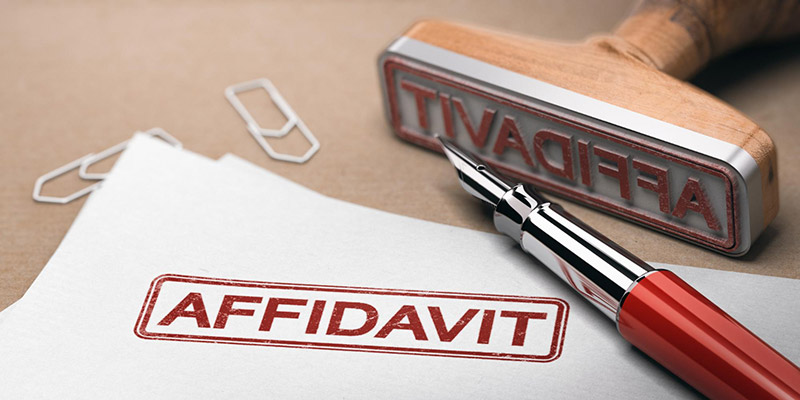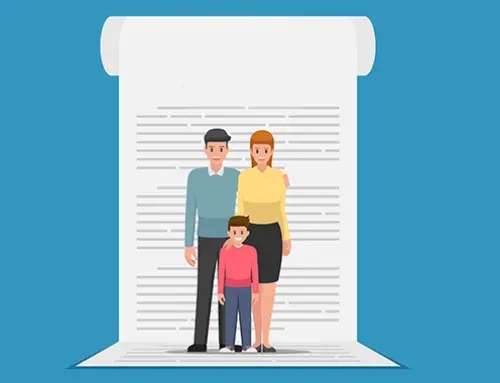Contents
How to Craft an Affidavit
An affidavit has seven parts. Most parts of the affidavit are technical. We will look at each of them in turn.
- Style of proceeding
- Deponent’s statement (“deponent’ is the person making the affidavit and is also called the “affiant”)
- Knowledge statement
- Body of the affidavit (this is the most important part of the affidavit)
- Ending of the affidavit
- Exhibits
- Backing sheet
1. Style of proceeding
The “Style of Proceeding” is the introductory section of a legal document, such as an affidavit, that provides essential details about the case for the court’s reference. It includes fundamental Information about the parties involved, the court where the case is being heard, the case number, and often the type of legal action being pursued.
In a typical affidavit, the style of proceeding is found at the top of the document and is crucial for identifying the case. It ensures that the affidavit is correctly associated with the ongoing litigation. In this section, you will see:
- Court Name: The court’s full name where the case is filed. For instance, “In the Supreme Court of New South Wales” or “In the Federal Court of Canada.”
- File Number or Docket Number: This is the unique number assigned to the case, such as “File No. 12345/2024.”
- Parties Involved: The names of the plaintiff(s) and defendant(s) or applicant(s) and respondent(s) in the proceeding. This is usually formatted as “John Doe v. Jane Smith” or “Applicant: John Doe, Respondent: Jane Smith” depending on the nature of the case.
- Type of Legal Action: Depending on the jurisdiction, the style may indicate the nature of the proceeding. For example, “In the matter of an Application for Judicial Review” or “Between [Party A] and [Party B] – Contract Dispute.”
When drafting the style of proceeding, it is essential to follow the jurisdiction’s specific format and conventions. As a lawyer, you aim to make this section clear, professional, and easy for court personnel to identify the case.
- Review the Jurisdiction’s Rules: Every court has its format requirements. Familiarize yourself with the particular jurisdiction’s expectations.
- Accurate Court Name: Ensure the court’s name is as precise as it appears in official documents. For example, it might be necessary to specify if it is a division of the court (e.g., “Family Division”).
- Party Names: List the parties. Start with the plaintiff or applicant, then the defendant or respondent. Be sure to use the full legal names and titles. If the party is a corporation, use the official registered name.
- Case Number: Include the court-issued case or file number. Verify that this number is accurate, as it is crucial for the proper filing of the document.
- Additional Information (if required): If the court rules require it, include additional details such as the type of proceeding or specific court division.

2. Deponent’s Statement
The deponent is the person making the affidavit, also called the “affiant.” The “Deponent’s Statement”, also known as the affiant’s statement, is a crucial section in an affidavit where the individual making the sworn statement (the deponent or affiant) formally declares the facts they are testifying to. This part of the affidavit contains the declarant’s personal account of the information relevant to the legal matter based on their knowledge, belief, or observations. The deponent swears or affirms that the facts stated are accurate to the best of their knowledge and subject to penalties for perjury if found to be untruthful.
The primary function of the deponent’s statement is to provide the court with an account of facts from the perspective of the person directly involved or knowledgeable about the situation. This section is the heart of the affidavit, as it outlines the evidence the deponent wishes to submit in support of a legal motion, defense, or another proceeding. It allows the court to evaluate the credibility of the evidence and make decisions based on the sworn testimony.
The deponent’s statement begins with the deponent’s personal identification. This includes the full legal name of the individual, their residence or business address, and sometimes their relationship to the parties in the legal case. The statement will generally begin with a sentence like:
“I, [deponent’s full name], of [address], declare as follows:”
The statement is typically structured in numbered paragraphs, with each paragraph addressing a specific fact or event. This clear format helps organize the testimony and makes it easier for the court to reference specific points during hearings. Depending on the case, the deponent’s statement may cover a wide range of subjects, such as the background of a legal dispute, a personal account of an incident, or explanations of relevant documentation.
The content of the deponent’s statement is based on their personal knowledge, meaning they have directly seen, heard, or experienced the facts they are swearing to. In some cases, the deponent may also include information they believe to be accurate, provided the source of that belief is reliable and the affidavit indicates the basis of this belief. This might include details obtained from third parties or documents.
For example, in an affidavit for a property dispute, the deponent might state:
“I have lived at the property located at [address] for 15 years, during which time I have continuously maintained the boundary fence on the northern side of the property.”
If the statement involves information not directly witnessed by the deponent but heard from another source, it may be prefaced with phrases like “I have been informed by [source] and believe it to be true.”
At the end of the deponent’s statement, the affiant must declare the truthfulness of their statement under oath. This is typically done in the concluding section, where the deponent swears or affirms the accuracy of the information. In jurisdictions that allow religious oaths, the deponent might “swear” to the truth of their statement before a commissioner of oaths. In contrast, those who prefer not to take a religious oath may “affirm” their statement instead.
The following is a common concluding phrase in an affidavit:
“I make this affidavit in good faith, believing the facts contained herein to be true, and aware that it is punishable by law to provide false testimony.”
3. Knowledge Statement
In this section, the deponent explicitly outlines whether the information presented in the affidavit is based on their direct personal knowledge or derived from other sources. If the information is not personally known, the deponent must identify the sources relied upon, such as documents, reports, or statements made by others. This distinction is crucial because it affects the affidavit’s evidentiary value, determining how much weight a court or tribunal will give to the deponent’s statements. Personal knowledge typically holds greater credibility and is less likely to be challenged, whereas information obtained second-hand may require further verification and could be scrutinized. This clarification helps the court assess the facts’ reliability, ensuring that only trustworthy and well-founded statements are considered during legal proceedings. Additionally, it prevents potential disputes about the source of the information, which could undermine the deponent’s credibility and the overall strength of the affidavit.
4. Body of the Affidavit
The body of the affidavit is the most crucial section, as it contains the substantive facts or statements that the deponent swears are true under oath. This section is where the deponent provides a clear, detailed, and structured account of the events or information relevant to the case. To ensure clarity and ease of reference, the body is typically organized into numbered paragraphs, with each paragraph addressing a separate point or fact. This organization allows the court, lawyers, and other parties to easily follow the deponent’s account and reference specific statements during legal proceedings.
Each paragraph should be concise and specific, focusing on one fact or event at a time to avoid confusion or ambiguity. Where possible, dates, times, names, and other specific details should be included to enhance the accuracy and reliability of the statements. The statements must be factual and not speculative, ensuring that the deponent only presents information within their personal knowledge or identifies when the information is derived from another source.
The body of the affidavit plays a crucial role in shaping the court’s understanding of the case. As a sworn statement, it provides the foundation upon which legal arguments may be built, evidence may be corroborated, and decisions may be made. This section’s clarity, organization, and accuracy directly influence the document’s effectiveness, making it essential for the deponent to be thorough and precise in their declarations.
5. Ending of the Affidavit
The affidavit’s ending serves as the formal conclusion, where the deponent acknowledges the truthfulness of the statements made within the document. This section is critical because the deponent swears or affirms, under penalty of perjury, that all the facts and statements provided in the affidavit are accurate to the best of their knowledge. The deponent’s signature affirms this commitment, giving legal force to the document and allowing it to be accepted as evidence in legal proceedings.
The ending includes several other essential elements, in addition to the deponent’s signature. It must state the exact date and place where the affidavit was signed. These details ensure the affidavit is current and legally compliant with jurisdictional requirements. The location of the signing is particularly important for determining the relevant laws governing the oath or affirmation.
Another crucial aspect is the inclusion of the signature and credentials of a commissioner of oaths, notary public, or another authorized official who has witnessed the deponent’s oath or affirmation. This official plays a pivotal role in ensuring that the deponent is aware of the legal significance of their statements and that they have signed the affidavit willingly and knowingly. The witness’s role is not merely procedural but ensures the affidavit adheres to the formalities required for it to be recognized as a legitimate legal document.
In some jurisdictions, additional formalities such as an official stamp or seal from the notary public or commissioner of oaths may be required to authenticate the affidavit. These measures play a crucial role in further protecting the integrity of the document and preventing fraud, providing a sense of security and trust in the legal process.
6. Exhibits
Exhibits are vital to an affidavit when the deponent refers to documents, photographs, contracts, or other pieces of evidence to support their statements. These exhibits provide tangible, verifiable proof that corroborates the facts presented in the affidavit, giving it greater credibility and weight in legal proceedings. Without supporting exhibits, the affidavit’s assertions may be viewed as unsubstantiated, reducing its overall effectiveness.
Each exhibit must be clearly labeled, typically with a letter (e.g., Exhibit A, Exhibit B) or number (e.g., Exhibit 1, Exhibit 2) to ensure ease of reference. These labels must correspond to how the exhibits are referenced within the body of the affidavit. For instance, when the deponent mentions a specific contract or photograph, they should refer to it directly, such as “See Exhibit A, the contract signed on [date],” or “Refer to Exhibit 1, a photograph of the accident site.” This clear cross-referencing enables the court, legal professionals, and other parties to quickly locate and understand the relevance of each piece of evidence.
The exhibits should be organized logically and presented in the order they are referenced in the affidavit. This structure enhances the affidavit’s flow and ensures that those reading the document can follow the deponent’s statements seamlessly alongside the supporting evidence. The exhibits must be accurate, complete, and authentic, as any inconsistencies between the affidavit and its exhibits could undermine the deponent’s credibility and potentially weaken the legal case.
Preparing exhibits often requires meticulous attention to detail, especially when dealing with complex evidence like financial records, lengthy contracts, or multiple documents. Depending on the nature of the evidence, the exhibits may also need to include additional details, such as authentication by the deponent, certification by a professional, or signatures from other parties involved.
Once attached, exhibits become an official part of the affidavit. In many jurisdictions, these exhibits must be identified in a list or table attached to the affidavit or certified by the deponent or legal professional as true and accurate copies of the originals. This extra layer of verification further strengthens the exhibits’ role in substantiating the deponent’s statements.
7. Backing Sheet
The backing sheet, a technical but indispensable part of the affidavit, serves as the document’s cover sheet. It is a key administrative tool that aids courts and legal professionals in identifying, organizing, and tracking the legal system’s affidavits. While it may not contain substantive content like the body or exhibits, the backing sheet plays a crucial role in ensuring that the affidavit is correctly categorized and associated with the right case and parties, thereby maintaining order and organization in the legal system.
Typically, the backing sheet will include several key pieces of information. This often begins with the full name of the case, listed at the top of the sheet, which consists of the names of the parties involved (e.g., Plaintiff vs. Defendant or Applicant vs. Respondent). This ensures that the affidavit is linked to the appropriate case file. It also lists the name of the court where the case is being heard, which is critical in jurisdictions with multiple court levels, such as trial courts, appellate courts, or specialized courts.
In addition to the case name and court, the backing sheet contains details about the deponent or the party submitting the affidavit. This often includes the full name, contact information (such as an address, phone number, or email), and sometimes the attorney’s contact details if the affidavit is being submitted on behalf of a client. This information ensures that the court and opposing parties can quickly identify and contact the deponent or their legal representation regarding the affidavit.
The backing sheet may also contain procedural information, such as the case number assigned by the court, the date of filing, and any relevant case reference codes. These details are essential for ensuring that the affidavit is filed correctly and is not misplaced or misfiled, among other case documents.
Moreover, the backing sheet acts as a protective cover for the affidavit and any accompanying exhibits, ensuring their safety and organization. It separates the affidavit from other filings in a case and allows for quick identification without the need to review the content of the affidavit itself, providing a sense of security about the safety of the documents.
In some jurisdictions, the backing sheet might also include additional fields, such as a brief description of the affidavit’s purpose, the name of the commissioner of oaths or notary public who witnessed the affidavit, and whether the affidavit is part of a specific motion or application within the case.
Final Thoughts
Overall, an affidavit is a crucial legal document structured in seven parts, each serving a specific purpose to ensure clarity, reliability, and legal compliance. From the “Style of Proceeding” to the “Backing Sheet,” every section contributes to the affidavit’s effectiveness in presenting sworn testimony. The precision in the deponent’s statement, the organization of exhibits, and the adherence to formalities such as the ending and signing by a notary or commissioner of oaths all play vital roles in making the affidavit a credible piece of evidence. By understanding and adhering to these technical components, legal professionals can ensure that affidavits are appropriately formatted, legally binding, and effective in advancing their case in court. The careful attention to detail in each part of the affidavit upholds its integrity and strengthens the legal arguments it supports.
Content Brief
This guide will serve as a comprehensive guide to drafting an affidavit, breaking down the seven essential components that every affidavit must include: Style of Proceeding, Deponent’s Statement, Knowledge Statement, Body of the Affidavit, Ending of the Affidavit, Exhibits, and the Backing Sheet. Each section will be explored in detail, outlining its purpose, the required legal formalities, and tips for accuracy and clarity. The guide will focus on the technical elements of constructing an affidavit, ensuring it is properly formatted, legally compliant, and effectively supporting a case. Legal professionals and individuals will find this guide helpful in understanding how to present sworn testimony clearly, organizedly, and reliably.
Disclaimer: The content provided on this blog is for informational purposes only and does not constitute legal, financial, or professional advice.







